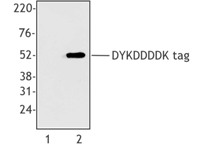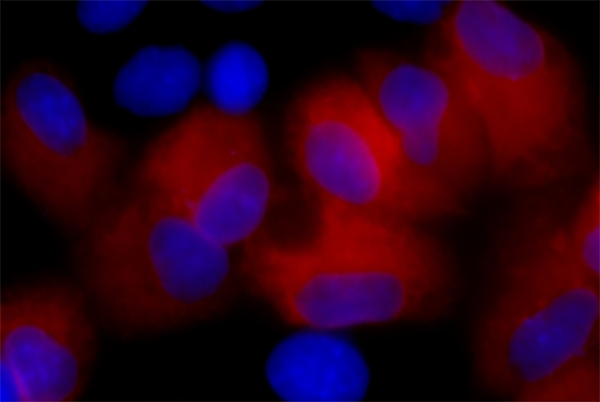- Clone
- L5 (See other available formats)
- Regulatory Status
- RUO
- Other Names
- FLAG tag
- Isotype
- Rat IgG2a, λ
- Ave. Rating
- Submit a Review
- Product Citations
- 36 publications

| Cat # | Size | Price | Quantity Check Availability | Save | ||
|---|---|---|---|---|---|---|
| 637309 | 25 µg | $117 | ||||
| 637310 | 100 µg | $360 | ||||
The DYKDDDDK tag, commonly referred to as Sigma®'s FLAG® Tag, is often used as a protein modification in order to simplify the labeling and detection of proteins.This unique amino acid sequence allows for specific antibody detection in western blotting, immunoprecipitation, and immunostaining techniques.Due to the short sequence, this modification is not likely to affect the structure or function of the modified proteins.
Product DetailsProduct Details
- Verified Reactivity
- Epitope tag
- Reported Reactivity
- Species independent
- Antibody Type
- Monoclonal
- Host Species
- Rat
- Immunogen
- DYKDDDDK-tagged mouse Langerin
- Formulation
- Phosphate-buffered solution, pH 7.2, containing 0.09% sodium azide.
- Preparation
- The antibody was purified by affinity chromatography and conjugated with PE under optimal conditions.
- Concentration
- 0.2 mg/ml
- Storage & Handling
- The antibody solution should be stored undiluted between 2°C and 8°C, and protected from prolonged exposure to light. Do not freeze.
- Application
-
FC - Quality tested
ICFC - Verified
- Recommended Usage
-
Each lot of this antibody is quality control tested by immunofluorescent staining with flow cytometric analysis. For flow cytometric staining, the suggested use of this reagent is ≤0.125 µg per million cells in 100 µl volume. It is recommended that the reagent be titrated for optimal performance for each application.
- Excitation Laser
-
Blue Laser (488 nm)
Green Laser (532 nm)/Yellow-Green Laser (561 nm)
- Application Notes
-
The L5 clone has been demonstrated to have 2-8 fold better sensitivity in WB than another commonly used antibody clone, M2.
-
Application References
(PubMed link indicates BioLegend citation) -
- Park SH, et al. 2008. J Immunol Methods. 331:27.
- Moon SH, et al. 2010. J. Biol Chem. 285:12935. PubMed
- Sasaki M, et al. 2011. J. Biol Chem. 286:39370. PubMed
- Sonder SU, et al. 2012. J Immunol. 188:5906. PubMed
- Jiang Y, et al. 2013. Int Immunol. 25:235. PubMed
- Zuo X, et al. 2014. PLoS One. 9:84748. PubMed
- Toyo-Oak K, et al. 2014. J Neurosci. 34:12168. PubMed
- Product Citations
-
- RRID
-
AB_2563147 (BioLegend Cat. No. 637309)
AB_2563148 (BioLegend Cat. No. 637310)
Antigen Details
- Biology Area
- Cell Biology
- Antigen References
-
1. Einhauer A. 2001. J. Biochem. Biophys. Methods. 49:455.
2. Knappik A and Pluckthun A. 1994. Biotechniques. 17:754. - Gene ID
- NA
- UniProt
- View information about DYKDDDDK on UniProt.org
Related Pages & Pathways
Pages
Related FAQs
- What type of PE do you use in your conjugates?
- We use R-PE in our conjugates.
Other Formats
View All DYKDDDDK Reagents Request Custom Conjugation| Description | Clone | Applications |
|---|---|---|
| Purified anti-DYKDDDDK Tag | L5 | WB,IP,ICC,ELISA,FC,Purification |
| Anti-DYKDDDDK Tag (L5) Affinity Gel | L5 | Purification,IP |
| APC anti-DYKDDDDK Tag | L5 | FC,ICFC |
| PE anti-DYKDDDDK Tag | L5 | FC,ICFC |
| Direct-Blot™ HRP anti-DYKDDDDK Tag | L5 | WB |
| Alexa Fluor® 594 anti-DYKDDDDK Tag | L5 | ICC |
| Alexa Fluor® 647 anti-DYKDDDDK Tag | L5 | ICC |
| Alexa Fluor® 488 anti-DYKDDDDK Tag | L5 | ICC |
| PE/Cyanine7 anti-DYKDDDDK Tag | L5 | FC |
| Brilliant Violet 421™ anti-DYKDDDDK Tag | L5 | FC |
| PerCP/Cyanine5.5 anti-DYKDDDDK Tag | L5 | FC |
| Ultra-LEAF™ Purified anti-DYKDDDDK Tag | L5 | WB,IP,ICC,ELISA,FC,Purification |
| PE/Dazzle™ 594 anti-DYKDDDDK Tag Antibody | L5 | FC |
| TotalSeq™-B1129 anti-DYKDDDDK Tag | L5 | PG |
| TotalSeq™-A1129 anti-DYKDDDDK Tag | L5 | PG |
| TotalSeq™-C1129 anti-DYKDDDDK Tag | L5 | PG |
Customers Also Purchased


Compare Data Across All Formats
This data display is provided for general comparisons between formats.
Your actual data may vary due to variations in samples, target cells, instruments and their settings, staining conditions, and other factors.
If you need assistance with selecting the best format contact our expert technical support team.
-
Purified anti-DYKDDDDK Tag

Cell extracts from untransfected 293T cells (lane 1) or 293T... -
Anti-DYKDDDDK Tag (L5) Affinity Gel

Anti-DYKDDDDK tag affinity resin (L5-agarose) retains bindin... 
Anti-DYKDDDDK tag affinity resin (L5-agarose) retains bindin... -
APC anti-DYKDDDDK Tag

HEK-293T cells transfected with plasmid encoding a DYKDDDDK-... -
PE anti-DYKDDDDK Tag

F-SIK2-FLAG transfected HEK293 cells were fixed and permeabi... -
Direct-Blot™ HRP anti-DYKDDDDK Tag
50 ng of recombinant GST protein tagged with the DYKDDDDK pe... -
Alexa Fluor® 594 anti-DYKDDDDK Tag

HeLa cells transiently transfected with DYKDDDDK tag fused p... -
Alexa Fluor® 647 anti-DYKDDDDK Tag

HeLa cells transiently transfected with DYKDDDDK tag fused p... 
HeLa cells transiently transfected with DYKDDDDK tag fused p... -
Alexa Fluor® 488 anti-DYKDDDDK Tag

HeLa cells non-transfected (A) or transfected with DYKDDDDK ... -
PE/Cyanine7 anti-DYKDDDDK Tag

DYKDDDDK tag-transfected cells were stained with anti-DYKDDD... -
Brilliant Violet 421™ anti-DYKDDDDK Tag

DYKDDDDK tag-transfected cells were stained with anti-DYKDDD... -
PerCP/Cyanine5.5 anti-DYKDDDDK Tag

DYKDDDDK tag-transfected cells were stained with anti-DYKDDD... -
Ultra-LEAF™ Purified anti-DYKDDDDK Tag

Cell extracts from untransfected 293T cells (lane 1) or 293T... -
PE/Dazzle™ 594 anti-DYKDDDDK Tag Antibody

DYKDDDDK tag-transfected cells were stained with anti-DYKDDD... -
TotalSeq™-B1129 anti-DYKDDDDK Tag
-
TotalSeq™-A1129 anti-DYKDDDDK Tag
-
TotalSeq™-C1129 anti-DYKDDDDK Tag

 Login/Register
Login/Register 




















Follow Us